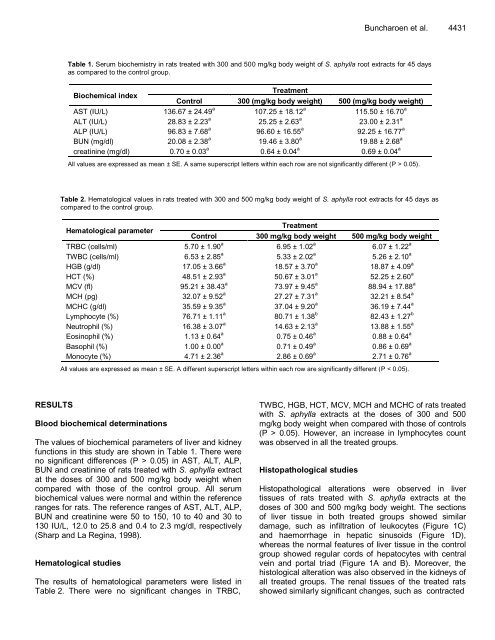Download Complete Issue (4740kb) - Academic Journals
Download Complete Issue (4740kb) - Academic Journals
Download Complete Issue (4740kb) - Academic Journals
You also want an ePaper? Increase the reach of your titles
YUMPU automatically turns print PDFs into web optimized ePapers that Google loves.
RESULTS<br />
Buncharoen et al. 4431<br />
Table 1. Serum biochemistry in rats treated with 300 and 500 mg/kg body weight of S. aphylla root extracts for 45 days<br />
as compared to the control group.<br />
Biochemical index<br />
Control<br />
Treatment<br />
300 (mg/kg body weight) 500 (mg/kg body weight)<br />
AST (IU/L) 136.67 ± 24.49 a 107.25 ± 18.12 a 115.50 ± 16.70 a<br />
ALT (IU/L) 28.83 ± 2.23 a 25.25 ± 2.63 a 23.00 ± 2.31 a<br />
ALP (IU/L) 96.83 ± 7.68 a 96.60 ± 16.55 a 92.25 ± 16.77 a<br />
BUN (mg/dl) 20.08 ± 2.38 a 19.46 ± 3.80 a 19.88 ± 2.68 a<br />
creatinine (mg/dl) 0.70 ± 0.03 a 0.64 ± 0.04 a 0.69 ± 0.04 a<br />
All values are expressed as mean ± SE. A same superscript letters within each row are not significantly different (P > 0.05).<br />
Table 2. Hematological values in rats treated with 300 and 500 mg/kg body weight of S. aphylla root extracts for 45 days as<br />
compared to the control group.<br />
Hematological parameter<br />
Control<br />
Treatment<br />
300 mg/kg body weight 500 mg/kg body weight<br />
TRBC (cells/ml) 5.70 ± 1.90 a 6.95 ± 1.02 a 6.07 ± 1.22 a<br />
TWBC (cells/ml) 6.53 ± 2.85 a 5.33 ± 2.02 a 5.26 ± 2.10 a<br />
HGB (g/dl) 17.05 ± 3.66 a 18.57 ± 3.70 a 18.87 ± 4.09 a<br />
HCT (%) 48.51 ± 2.93 a 50.67 ± 3.01 a 52.25 ± 2.60 a<br />
MCV (fl) 95.21 ± 38.43 a 73.97 ± 9.45 a 88.94 ± 17.88 a<br />
MCH (pg) 32.07 ± 9.52 a 27.27 ± 7.31 a 32.21 ± 8.54 a<br />
MCHC (g/dl) 35.59 ± 9.35 a 37.04 ± 9.20 a 36.19 ± 7.44 a<br />
Lymphocyte (%) 76.71 ± 1.11 a 80.71 ± 1.38 b 82.43 ± 1.27 b<br />
Neutrophil (%) 16.38 ± 3.07 a 14.63 ± 2.13 a 13.88 ± 1.55 a<br />
Eosinophil (%) 1.13 ± 0.64 a 0.75 ± 0.46 a 0.88 ± 0.64 a<br />
Basophil (%) 1.00 ± 0.00 a 0.71 ± 0.49 a 0.86 ± 0.69 a<br />
Monocyte (%) 4.71 ± 2.36 a 2.86 ± 0.69 a 2.71 ± 0.76 a<br />
All values are expressed as mean ± SE. A different superscript letters within each row are significantly different (P < 0.05).<br />
Blood biochemical determinations<br />
The values of biochemical parameters of liver and kidney<br />
functions in this study are shown in Table 1. There were<br />
no significant differences (P > 0.05) in AST, ALT, ALP,<br />
BUN and creatinine of rats treated with S. aphylla extract<br />
at the doses of 300 and 500 mg/kg body weight when<br />
compared with those of the control group. All serum<br />
biochemical values were normal and within the reference<br />
ranges for rats. The reference ranges of AST, ALT, ALP,<br />
BUN and creatinine were 50 to 150, 10 to 40 and 30 to<br />
130 IU/L, 12.0 to 25.8 and 0.4 to 2.3 mg/dl, respectively<br />
(Sharp and La Regina, 1998).<br />
Hematological studies<br />
The results of hematological parameters were listed in<br />
Table 2. There were no significant changes in TRBC,<br />
TWBC, HGB, HCT, MCV, MCH and MCHC of rats treated<br />
with S. aphylla extracts at the doses of 300 and 500<br />
mg/kg body weight when compared with those of controls<br />
(P > 0.05). However, an increase in lymphocytes count<br />
was observed in all the treated groups.<br />
Histopathological studies<br />
Histopathological alterations were observed in liver<br />
tissues of rats treated with S. aphylla extracts at the<br />
doses of 300 and 500 mg/kg body weight. The sections<br />
of liver tissue in both treated groups showed similar<br />
damage, such as infiltration of leukocytes (Figure 1C)<br />
and haemorrhage in hepatic sinusoids (Figure 1D),<br />
whereas the normal features of liver tissue in the control<br />
group showed regular cords of hepatocytes with central<br />
vein and portal triad (Figure 1A and B). Moreover, the<br />
histological alteration was also observed in the kidneys of<br />
all treated groups. The renal tissues of the treated rats<br />
showed similarly significant changes, such as contracted

















